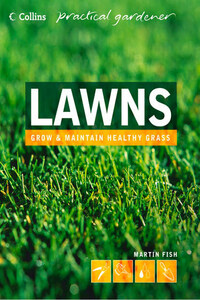Copyright
HarperCollinsPublishers 77â85 Fulham Palace Road, London W68JB
www.harpercollins.co.uk
First published in 2005 by HarperCollinsPublishers
Text by Martin Fish; copyright © HarperCollinsPublishers
Artworks and design © HarperCollinsPublishers
The majority of photographs in this book were taken by Tim Sandall.
A number of other images were supplied by David Sarton Cover photography by Tim Sandall Photographic props: Coolings Nurseries, Rushmore Hill,
Knockholt, Kent, TN14 7NN,
www.coolings.co.uk
Design and editorial: Focus Publishing, Sevenoaks, Kent
Project editor: Guy Croton
Editor: Vanessa Townsend Project co-ordinator: Caroline Watson Design & illustration: David Etherington
For HarperCollins
Senior managing editor: Angela Newton Design manager: Luke Griffin Editor: Alastair Laing Assistant editor: Lisa John Production: Chris Gurney
A catalogue record for this book is available from the British Library
All rights reserved under International and Pan-American Copyright Conventions. By payment of the required fees, you have been granted the nonexclusive, nontransferable right to access and read the text of this eâbook onâscreen. No part of this text may be reproduced, transmitted, downloaded, decompiled, reverseâengineered, or stored in or introduced into any information storage and retrieval system, in any form or by any means, whether electronic or mechanical, now known or here in after invented, without the express written permission of HarperCollins eâbooks.
HarperCollinsPublishers has made every reasonable effort to ensure that any picture content and written content in this ebook has been included or removed in accordance with the contractual and technological constraints in operation at the time of publication.
Source ISBN 9780007182664
Ebook Edition © JULY 2014 ISBN: 9780007596652
Version: 2014â08â22
Lawns come in all shapes and sizes, from manicured and striped lawns to tough hardwearing areas of grass. To many, looking after a lawn is a chore and is not considered very important. Yet from a garden design point of view, lawns are very important, and many people would not consider creating a garden without a lawn of some sort. Although gardening trends come and go, the lawn is definitely here to stay. It provides not only an attractive feature but a surface for play and an area in which to relax in the garden. It also acts as a foil to plants and borders â take away the lawn and the garden would be much less interesting to look at. Even in the middle of winter when the garden can look a little bare, a lawn will always provide some colour.
Despite the importance of lawns, they are often taken for granted and only given the minimum of care. Part of the reason for this is because it is widely believed that to have a good quality lawn you need to spend a great deal of time and money on maintenance. In the case of a golf green or football pitch this may be the case, but for a garden lawn it is possible to create and maintain a lawn in good condition without being a slave to it. Lawn care is also thought to be difficult and a bit of a mystery, but with improved and new varieties of grass and an increasing range of lawn care products, lawn maintenance has never been as easy or enjoyable. A well kept lawn will involve some work, but the results far outweigh the effort and if you treat your lawn as being as important as the rest of the other features and plants in your garden, the whole area will appear to be more aesthetically pleasing to the eye.
This book is aimed at gardeners who appreciate that a lawn is an important part of the garden and for those who want to create a new lawn or maintain and improve an existing one. It is also for those who might want to try something a little different in their garden â a break from tradition. Lawns can be used in many other ways such as for growing wild flowers, lawn sculptures and to create mown shapes to add interest and movement to the garden.
A well kept lawn is a thing of beauty and need not involve as much hard work as you might think








